How to Wear Body Ornaments from the Ancient Americas
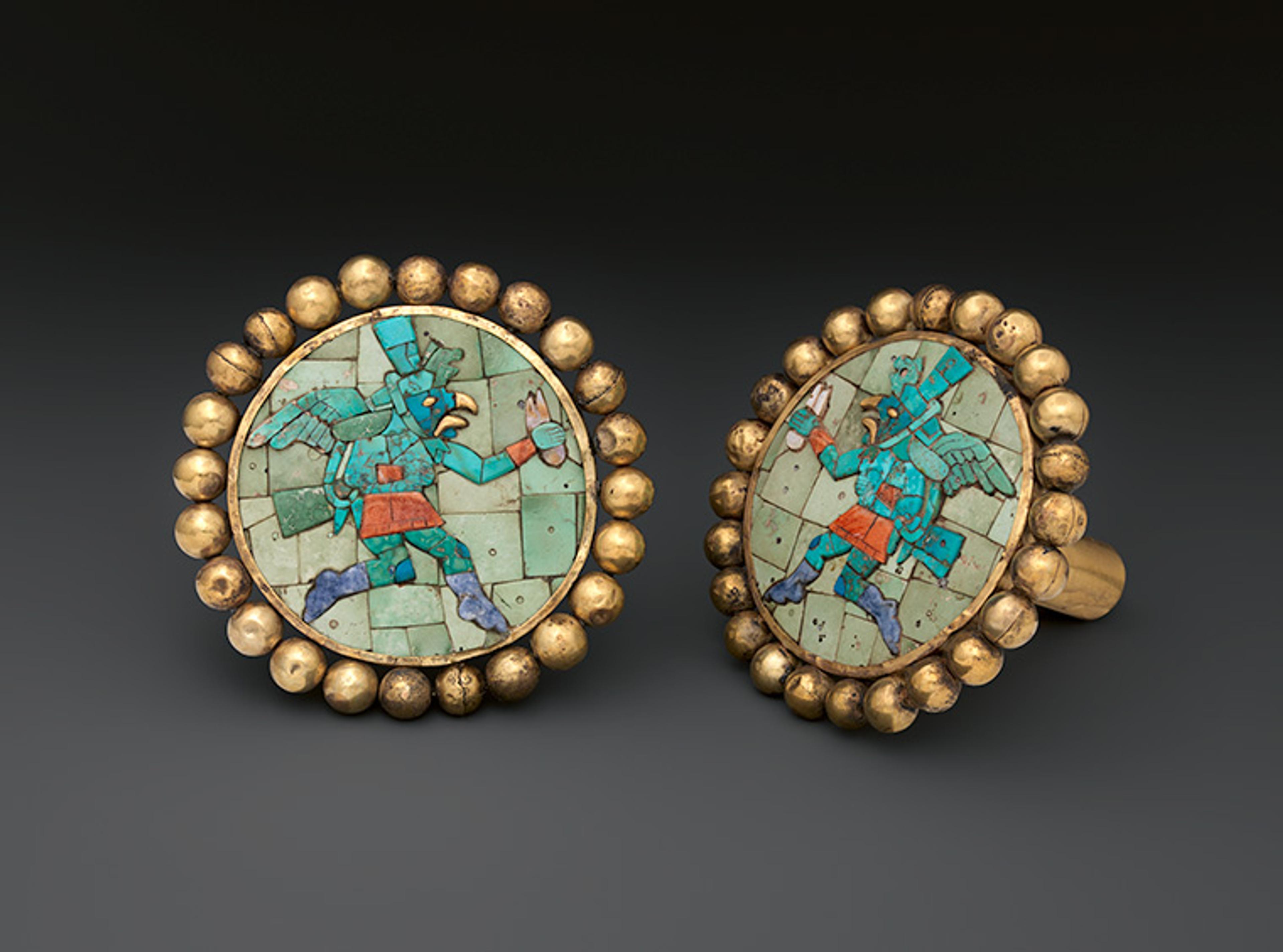
Pair of ear ornaments with winged runners, A.D. 400–700. Peru. Moche. Gold, turquoise, sodalite, shell, 3 1/4 in. (8 cm). The Metropolitan Museum of Art, New York, Gift and Bequest of Alice K. Bache, 1966, 1977 (66.196.40-.41)
«Take a look at the objects pictured above. How do you think they were worn? You can't try them on at The Met, but there is so much to discover about the people who wore them hundreds of years ago. Adornments for the body, such as the ear ornaments shown here, have been found throughout the ancient Americas. At first glance, you may not know how these objects were used. Let's check out different kinds of body ornaments and discover how they were worn in the past!»
Ear Ornaments

Close up of one of the ear ornaments
Unlike modern-day earrings, these ear ornaments have no backings. The post that goes through the earlobe balances the front to keep it from falling out. The front of each ear ornament is large—almost 3 1/4 inches wide. The width of a Metrocard or driver's license is only a little wider! These ornaments were likely worn with the winged, bird-like figures facing inward towards the face. These figures seem to be running, possibly to deliver an important message to the wearer.
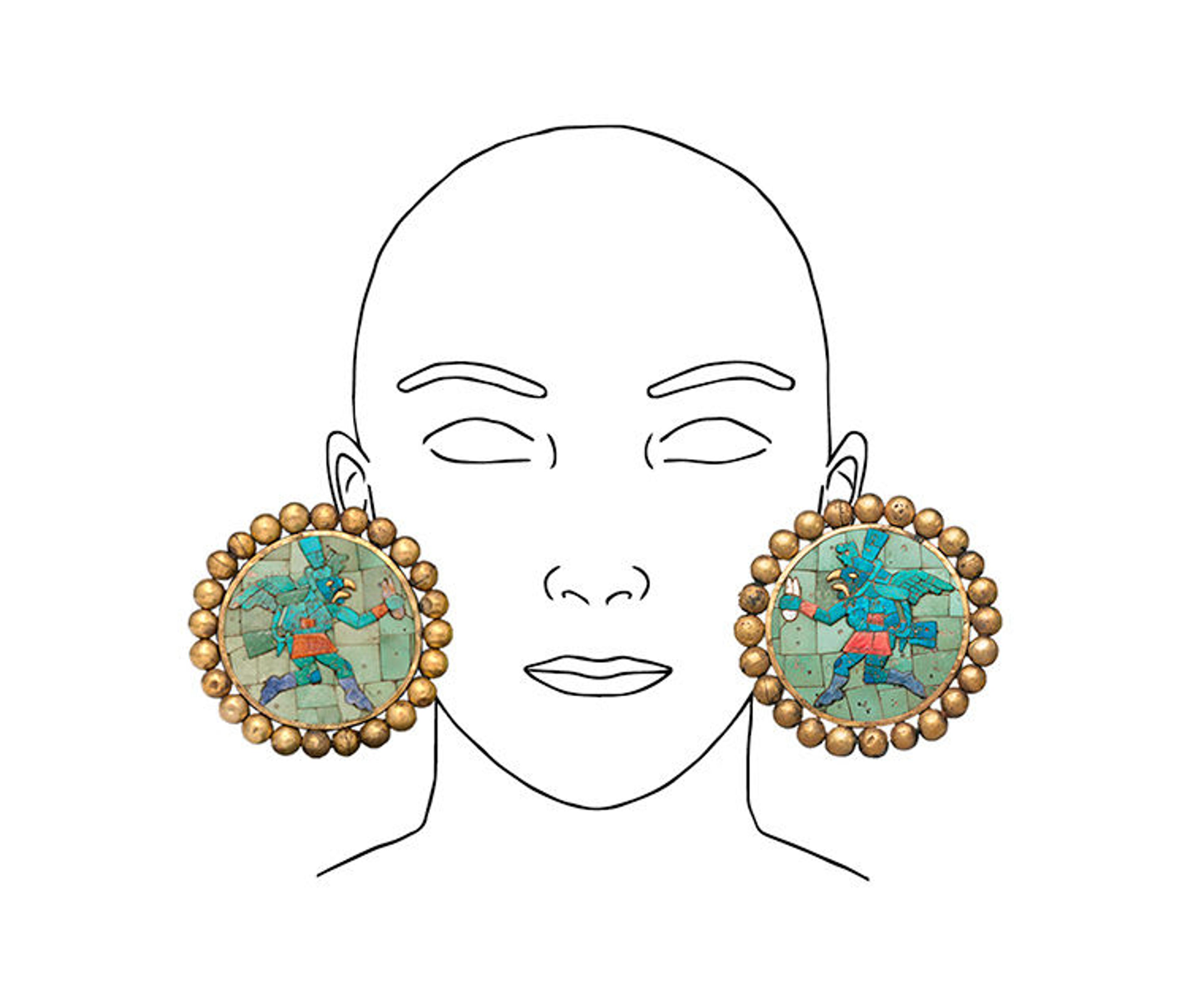
Digital rendering of how this pair of ear ornaments with winged runners would have been worn. Image by the author, using a face template by Allia Benner
The Moche, who lived on the north coast of Peru, created this pair of ear ornaments over 1,000 years ago. Ear ornaments have been discovered at archaeological sites across the Americas, from Peru to Mexico. For many years, experts believed that these objects were only worn by important men. Recent studies, however, have revealed that ear ornaments were worn by powerful women too! Girls and boys in high-ranking families had their ears pierced and wore large ear ornaments to stretch the holes. Long, droopy earlobes were a sign of power—sometimes they even hung down to their shoulders!
Labrets

Serpent labret with articulated tongue, A.D. 1300–1521. Mexico, Aztec. Gold, H. 2 5/8 x W.1 3/4 x D. 2 5/8 in. (6.67 x 4.45 x 6.67 cm). The Metropolitan Museum of Art, New York, Purchase, 2015 Benefit Fund and Lila Acheson Wallace Gift, 2016 (2016.64)
Look out! This labret, or lip ornament, is in the shape of a serpent ready to strike! The Aztec created this labret around 500 to 700 years ago. They believed serpents were powerful supernatural creatures that helped rulers and heroes. One of the most important Aztec gods is even named the Feathered Serpent.

Digital rendering of how the serpent labret with articulated tongue would have been worn. Image by the author
Aztec rulers wore labrets to symbolize their ability to speak with care and precision. It was worn inserted through a pierced opening in the lower lip. The labret was held in place by the flange—the flat, extended tabs on either side of the circular base. The flange was laid against the inside of the mouth.
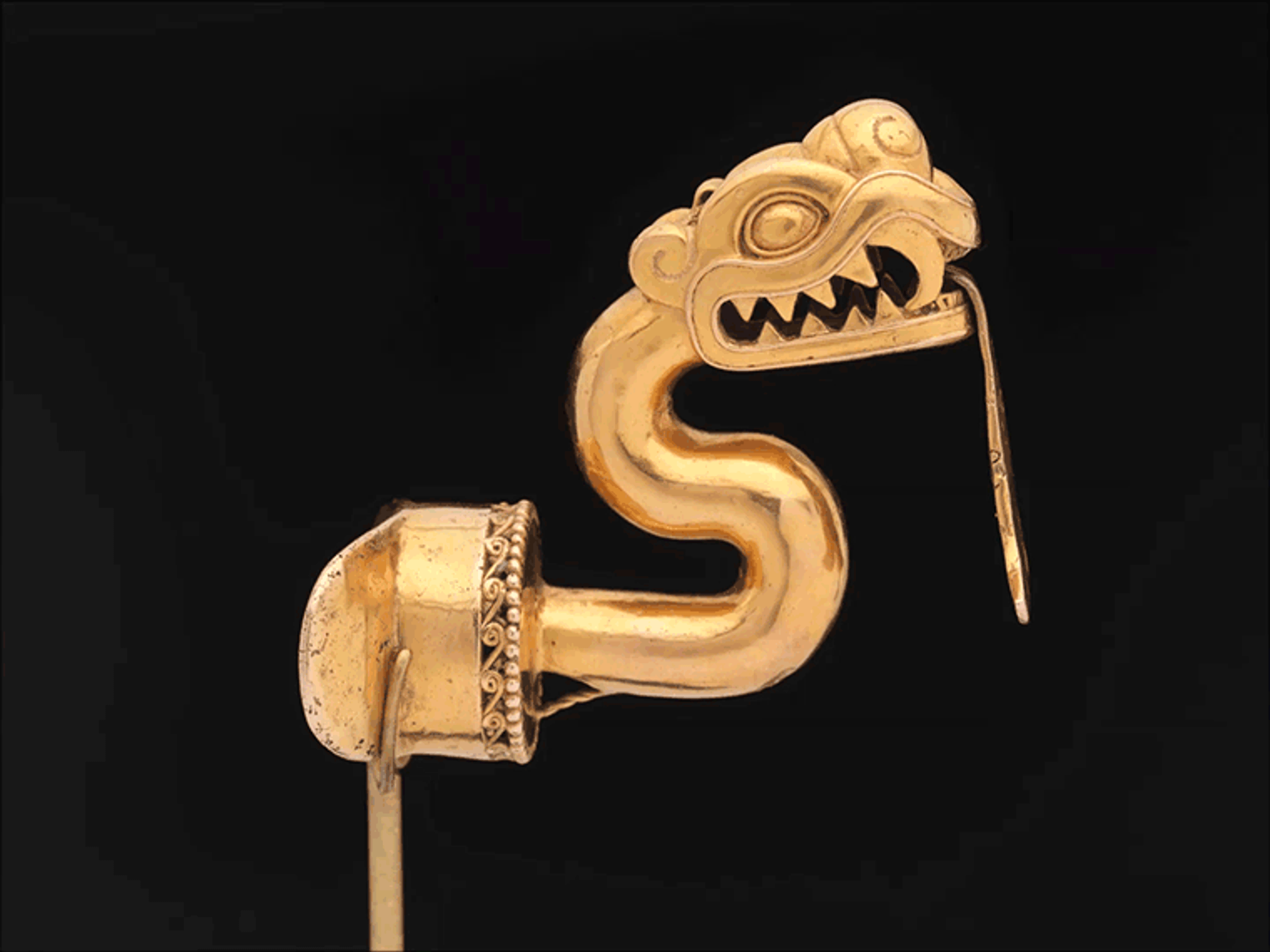
Animated GIF of serpent labret with articulated tongue
As you can see, this labret can move! The serpent's tongue can swing from side to side and move in and out. Royals and nobles wore labrets to show their power. They wore gold labrets for very special occasions like battles and ceremonies.
Nose Ornaments

Nose ornament with spiders, 100 B.C.–A.D. 200. Peru, North Coast. Salinar. Gold, H. 2 x W. 4 3/8 x D. 1/8 in. (5.1 x 11.1 x 0.3 cm). The Metropolitan Museum of Art, New York, The Michael C. Rockefeller Memorial Collection, Bequest of Nelson A. Rockefeller, 1979 (1979.206.1172)
Four spiders sit in a delicate golden web. If you've looked at a real spider up-close, what have you noticed? Spiders are arachnids, which means that they each have eight legs and a two-part body. You can see these body parts in the nose ornament. The spiders' round bodies have been made from gold sheet. Their spindly legs have been created from thin gold wire.
How do you react when you see a spider? In ancient Peru, spiders were considered bearers of good news! They often appeared right before the rain, and rain was important in the desert-like environments of coastal Peru. Spiders were also admired for their ability to catch live prey with their sticky webs. They were like great warriors who captured prisoners in battle.
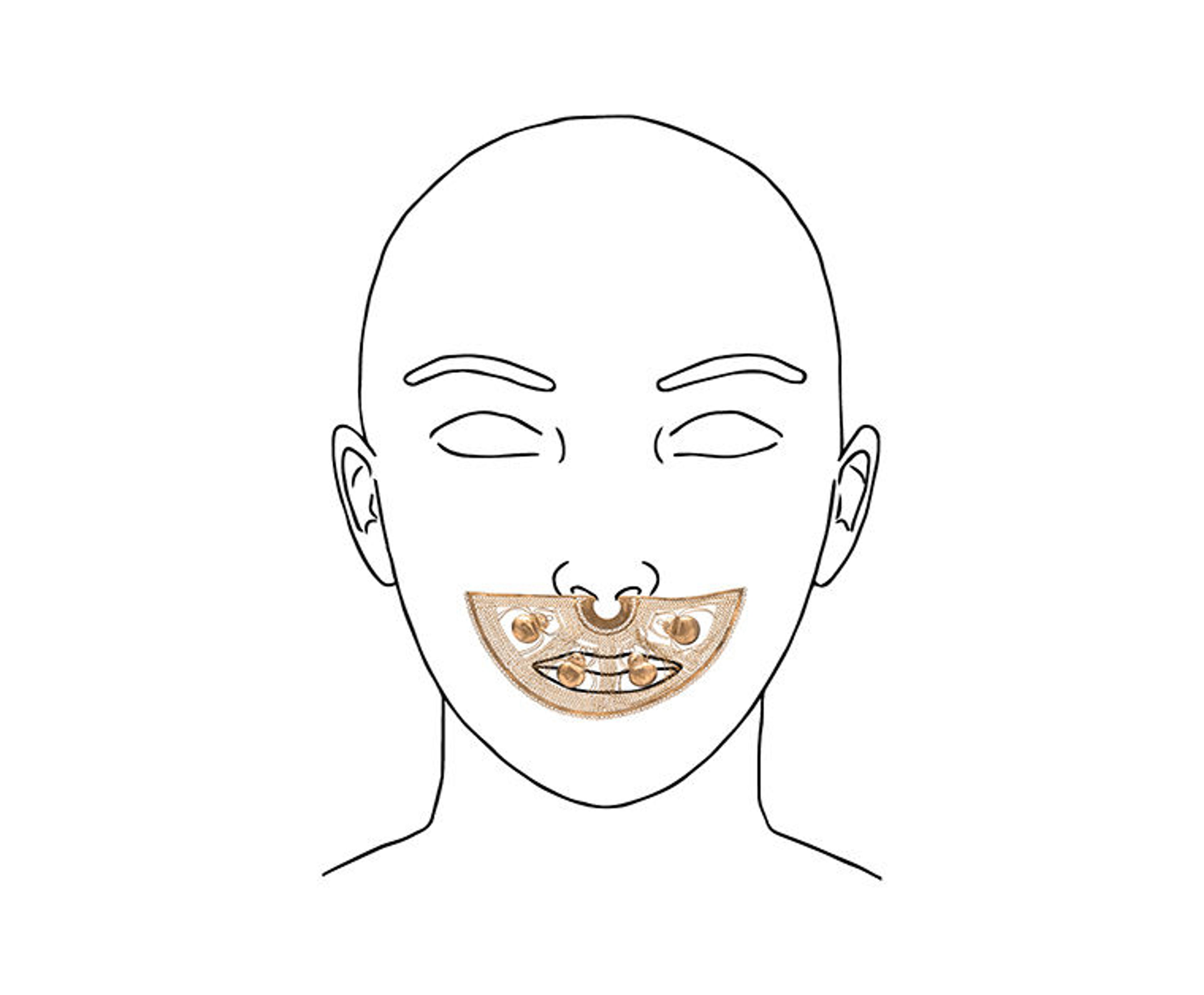
Digital rendering of how nose ornament with spiders would have been worn. Image by the author, using a face template by Allia Benner
This gold nose ornament is from the Salinar culture of Peru. Created nearly 2,000 years ago, it's one of the oldest body ornaments discovered in the region! It was worn suspended from the nasal septum—the internal wall, inside your nose, that separates the nostrils. Like other nose ornaments made from precious metals, it was created for an important person.
Masks
This funerary mask does not have holes for the eyes or the nose. A person wearing the mask would not be able to see or breathe! That's because a funerary mask is made for someone who is no longer alive.
Funerary mask, A.D. 900–1100. Peru, North Coast. Lambayeque (Sicán). Gold, silver-copper overlays, cinnabar, H. 11 1/2 in. x W. 19 1/2 in. x D. 4 in. (29.2 x 49.5 x 10.2 cm). The Metropolitan Museum of Art, New York, Gift and Bequest of Alice K. Bache, 1974, 1977 (1974.271.35)
This mask was created 1,000 years ago by the Lambayeque (also known as the Sicán) culture. They lived on the North Coast of Peru. The pointed eyes of the mask are those of the Sicán Deity, a legendary figure believed to have founded the Lambayeque culture. An individual buried with such a mask was thought to gain some of the Sicán Deity's power in the afterlife!
Archaeologists have found as many as five masks in a single burial. Some of these masks were attached to the head of the person, while others were stacked at the feet. The Lambayeque created the masks and other regalia to be buried with important men and women.

Entrance to the exhibition Golden Kingdoms: Luxury and Legacy in the Ancient Americas
Come see these body ornaments in person. Share with your friends and family how they were worn! Golden Kingdoms: Luxury and Legacy in the Ancient Americas is on view from February 28th to May 28th, 2018 in Gallery 199.
Visit #MetKids, a digital feature made for, with, and by kids! Discover fun facts about works of art, hop in our time machine, watch behind-the-scenes videos, and get ideas for your own creative projects.
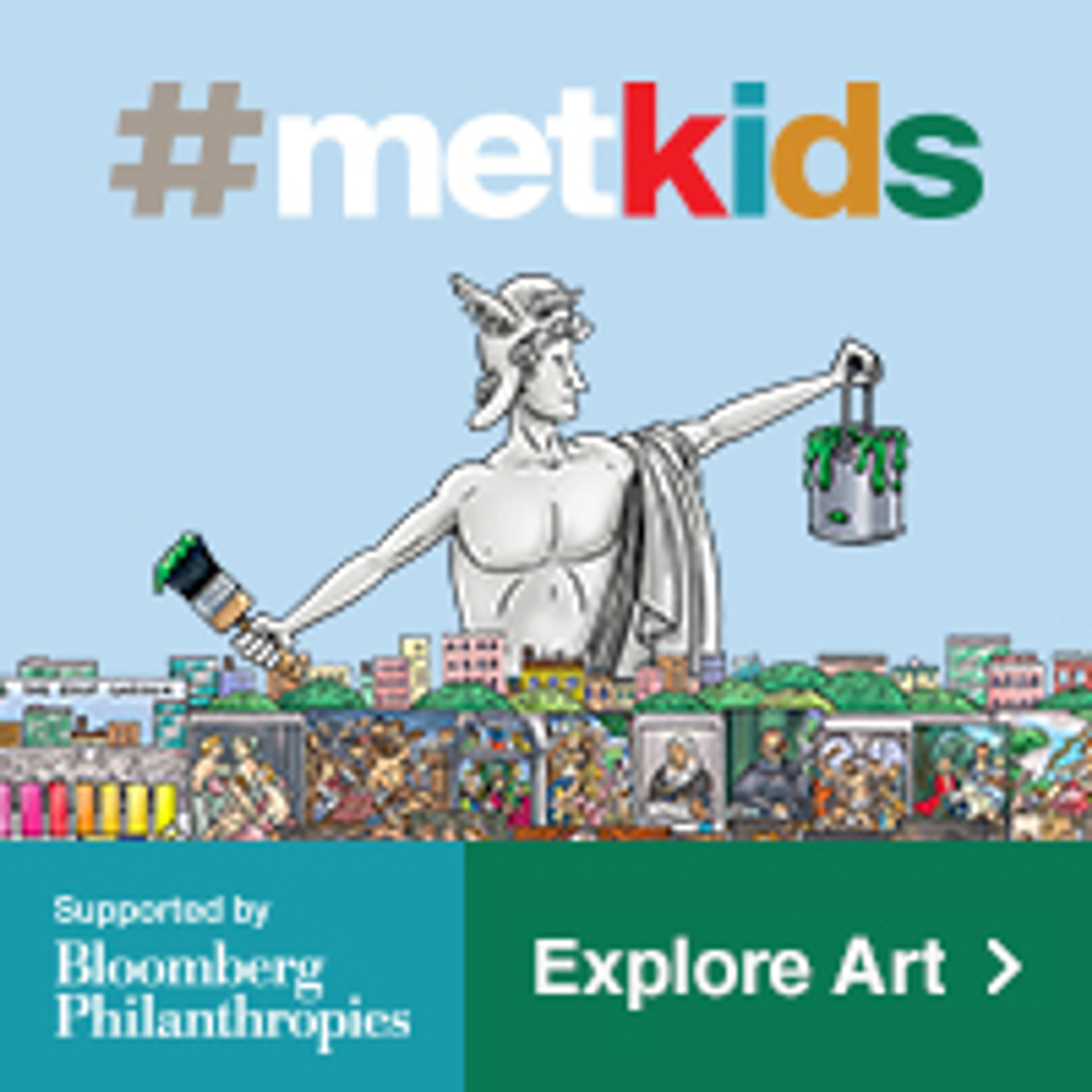
Ji Seo
Ji Mary Seo is the Lifchez-Stronach Curatorial Intern in the Department of the Arts of Africa, Oceania, and the Americas.